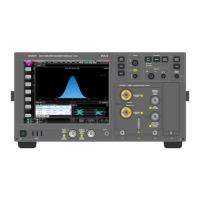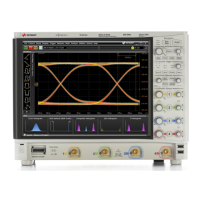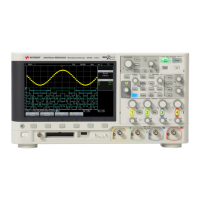122 Keysight InfiniiVision 1200 X-Series and EDUX1052A/G Oscilloscopes User's Guide
12 Trigger Mode/Coupling
Noisy Signals If the signal you are probing is noisy, you can set up the oscilloscope to reduce the
noise in the trigger path and on the displayed waveform. First, stabilize the
displayed waveform by removing the noise from the trigger path. Second, reduce
the noise on the displayed waveform.
1 Connect a signal to the oscilloscope and obtain a stable display.
2 Remove the noise from the trigger path by turning on high-frequency rejection
("To enable or disable trigger HF Reject" on page 125), low-frequency
rejection ("To select the trigger coupling" on page 124), or "To enable or
disable trigger noise rejection" on page 125.
3 Use "Averaging Acquisition Mode" on page 138 to reduce noise on the
displayed waveform.
To select the Auto or Normal trigger mode
When the oscilloscope is running, the trigger mode tells the oscilloscope what to
do when triggers are not occurring.
In the Auto trigger mode (the default setting), if the specified trigger conditions are
not found, triggers are forced and acquisitions are made so that signal activity is
displayed on the oscilloscope.
In the Normal trigger mode, triggers and acquisitions occur only when the
specified trigger conditions are found.
To select the trigger mode:
1 Press the [Trigger] key.
2 In the Trigger menu, press the Mode softkey; then select either Auto or Normal.
See the following "When to Use Auto Trigger Mode" on page 123 and "When
to Use Normal Trigger Mode" on page 123 descriptions.
You can also configure the [Quick Action] key to toggle between the Auto and
Normal trigger modes. See "Configuring the [Quick Action] Key" on page 246.
Triggering and the
Pre- and
Post-Trigger
Buffers
After the oscilloscope starts running (after pressing [Run] or [Single] or changing
the trigger condition), the oscilloscope first fills the pre-trigger buffer. Then, after
the pre-trigger buffer is filled, the oscilloscope starts searching for a trigger, and
sampled data continues to flow data through the pre-trigger buffer in a first-in
first-out (FIFO) manner.

